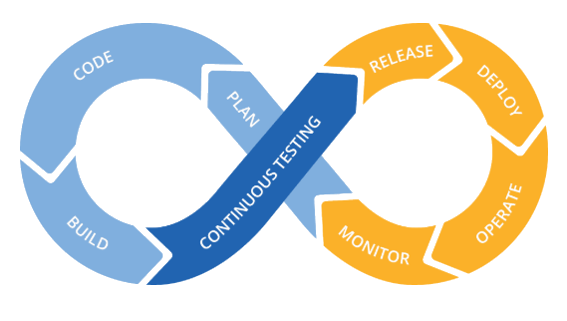Technology has become integral to our daily lives, and businesses of all sizes depend on software to operate. As companies advance in their digital transformation journey, they prioritize delivering innovative software quickly and with greater agility. You don't want your QA process to be a bottleneck, hindering the company's ability to deliver at the necessary pace, but you also need to ensure high-quality, bug-free software.
Continous Testing Approach
Balancing the need for speed with acceptable risk levels necessitates Continuous Testing, which delivers real-time insights into the application's business risks.
Continuous Testing is an all-encompassing QA process that involves running automated tests consistently to deliver rapid and regular feedback on the business risks tied to a software release. This approach expands upon test automation by incorporating risk-based test case design and prioritization, effective management of stateful test data, test-driven service virtualization, and smooth integration with the DevOps toolchain.

Traditional testing methods yield results only at the end of the development cycle. In contrast, Continuous Testing occurs at multiple stages, including requirements review, development, integration, staging, and production. This approach allows defects to be addressed much earlier, enhancing overall quality and significantly saving time and money.
To implement Continuous Testing in an organization, consider the following:
- Align testing with business risks to optimize test execution, implement automated quality gates, and provide crucial insights for release decisions.
- Reduce manual testing in favor of session-based exploratory testing.
- Shift testing efforts to the API layer whenever possible.
- Use test data management and service virtualization to enable continuous execution of realistic end-to-end tests.
- Integrate functional testing into CI/CD to ensure it becomes a seamless part of the delivery pipeline.

Transition from QA to QE
Workforce Transformation
- Evaluating and reskilling existing testing teams is crucial for shifting from QA to QE.
- This transformation involves updating the team's mindset, skills, and tools, as well as fostering a culture change. By doing so, organizations move from “testing as a people activity” to “testing as a service”.
Upstream Testing:
- The traditional approach of testing post-development is being replaced by testing from the very beginning of the software development lifecycle.
- Incorporating feedback and continuous integration during development allows testers to participate in design sessions and establish strategies for proactive testing.
Automation Framework:
- Developing a robust automation framework is essential for transitioning to QE
- Bot implementation to act with the process significantly and in a proper way.
- While routine testing processes are commonly automated, there's significant potential to expand automation's role using data analytics tools that provide insights into customer experience and inform decision-making.
Enterprise CI/CD:
- Implementing a Continuous Integration (CI) and Continuous Deployment (CD) pipeline saves time and reduces errors associated with manual deployment.
- This pipeline supports upstream testing and ensures quality is embedded from the start.
- We help you to improve the process and optimization of RPA, as per your strategy.
- Automated tests can be scheduled to run after each deployment, further enhancing efficiency.
Crowdsourcing:
- Leveraging crowdsourcing platforms allows organizations to tap into public, private, and certified communities for various tasks.
- This approach accelerates design, coding, testing, and data science efforts by accessing a broader range of ideas and paying only for outcomes that meet requirements.
Outcome-Based Model:
- Adopting an outcome-based model increases efficiency and reduces operational costs.
- By using measurable performance metrics, organizations can align their QE processes with desired outcomes, moving away from costlier managed capacity models.
- This approach ensures transparency and aligns rewards with risks.
Conclusion
As organizations embrace digital transformation, incorporating DevOps and CI/CD practices, it's vital to integrate QA into this continuous approach to testing. Transforming QA into continuous testing and QE enables enterprises to adapt effectively to digital changes and ensure a high-quality customer experience.
With frequent deployments, it's essential that QA doesn't become a bottleneck, allowing organizations to deliver new, quality functionality swiftly to customers. Consequently, leading enterprises and top CIOs are prioritizing QA to achieve their digital transformation goals.
Starting QA to QE journey.
Contact UsOur Location
HEAD OFFICE
Office no-104, Tulip Building, Godrej Hill
Barave Road
Kalyan (West)
Maharashtra 421301
+91 8585854488
BRANCH OFFICE(Bangalore)
VMSYS IT Solutions PVT LTD, #19,3rd Floor
19th B Cross, 7th Main
BTM 2nd Stage,Bangalore
Karntaka 560076
+91 8585854488
BRANCH OFFICE(Telangana)
VMSYS IT Solutions PVT LTD,Corporate Office:H.No-3-4-391
Plot No-6,Ground Floor,Laxmi Nagar Colony,West Marredpally,Secunderabad
Telangana 500026
+91 8585854488


